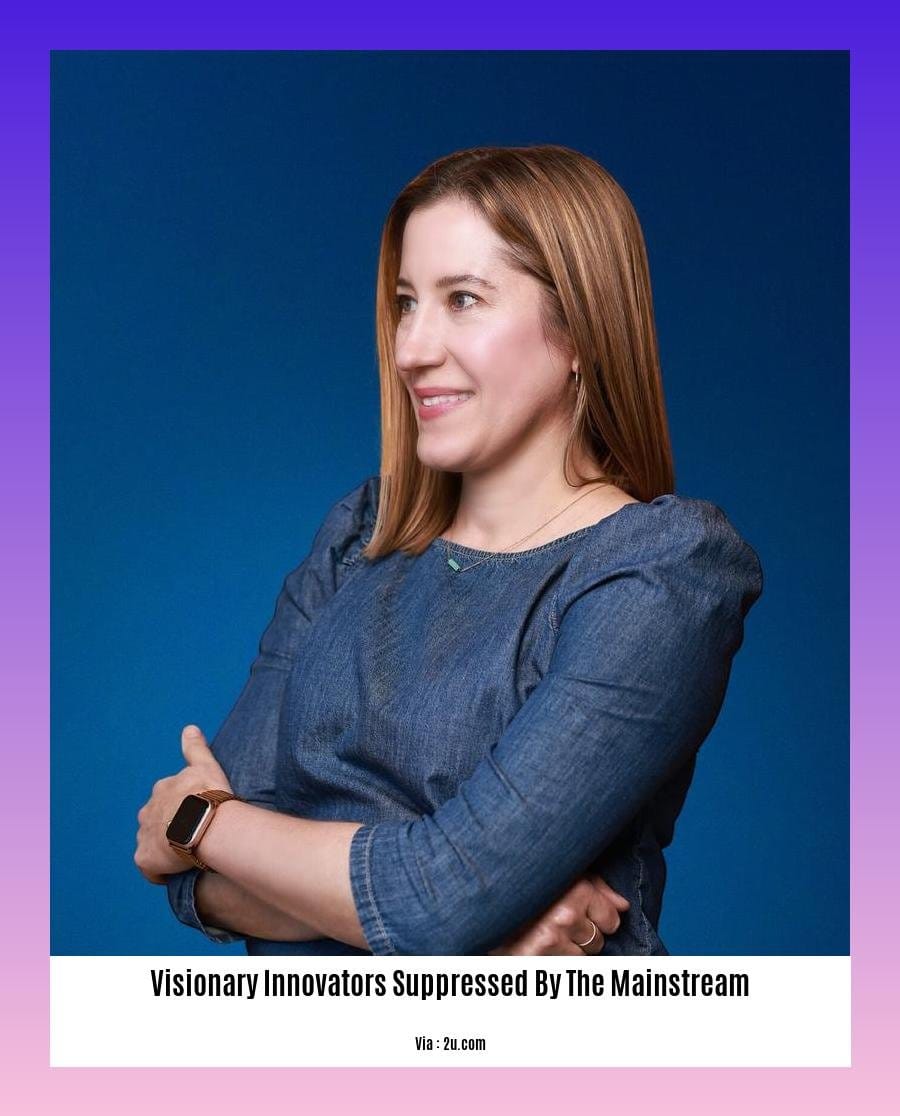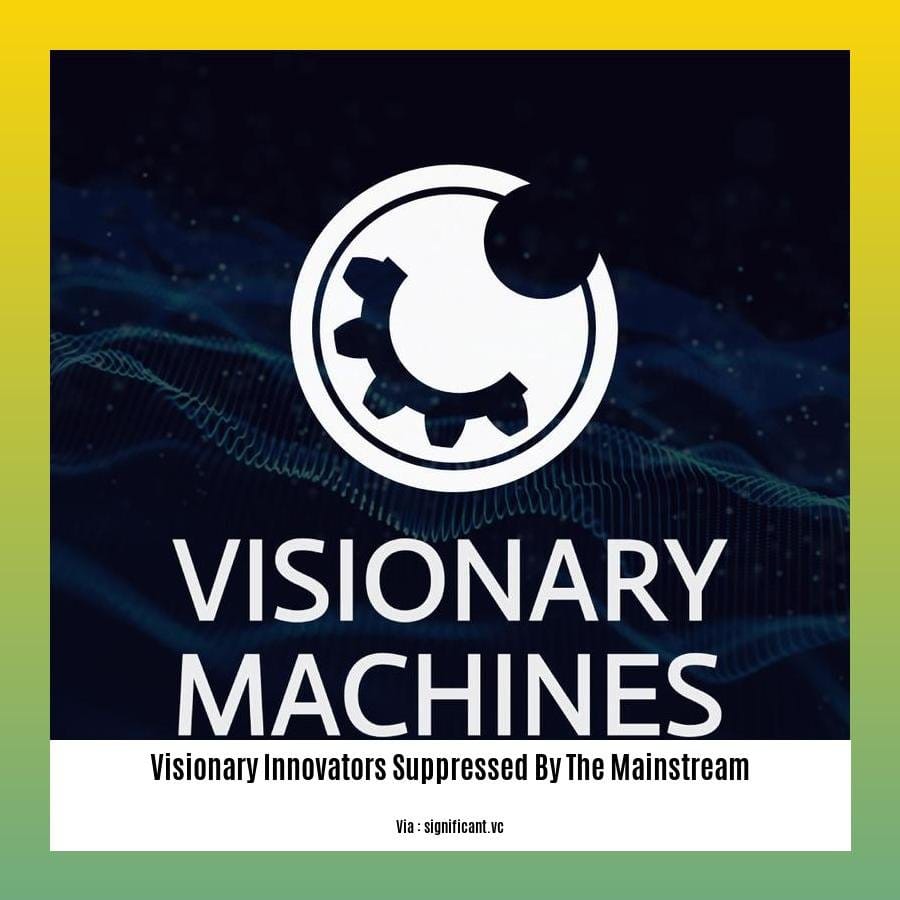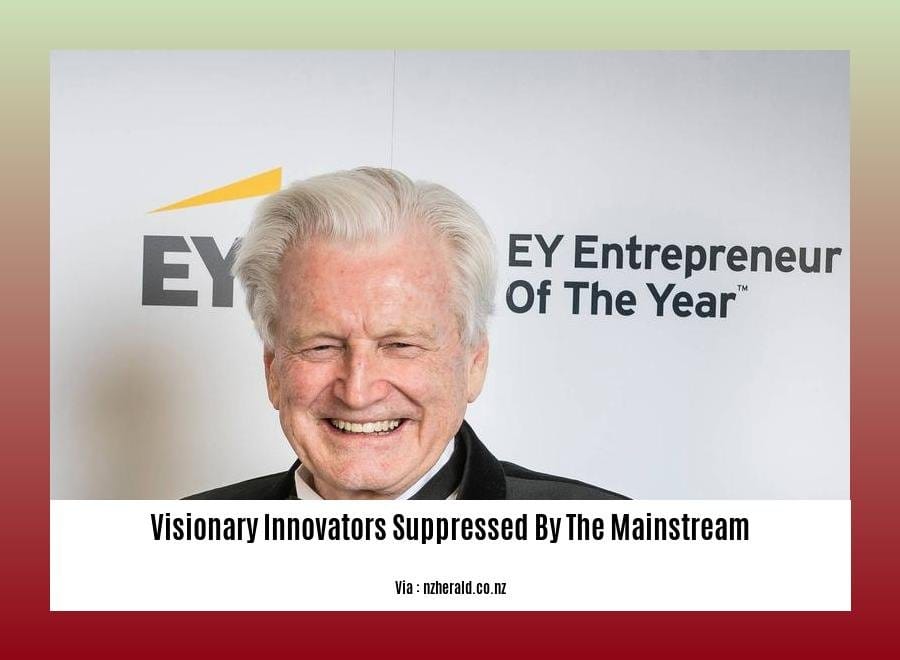Unveiling the untold stories of Visionary Innovators Suppressed by the Mainstream: Stories of Unsung Ingenuity, we delve into the fascinating narratives of those whose ideas challenged societal norms.
Key Takeaways:

- Visionary innovators envision future possibilities that transcend current limitations.
- They are change-makers and risk-takers who push boundaries.
- Committed innovators embrace experimentation, risk-taking, and value creation.
- Leading innovators focus on strategic clarity, customer-centricity, and experimentation.
- Visionary leaders attract followers and promote group identity through novel solutions.
The Unsung Ingenuity of Visionary Innovators Suppressed by the Mainstream
Visionaries who challenge prevailing norms and push the boundaries of innovation often face resistance and suppression from the very society that should embrace them. Despite the transformative potential of their ideas, these visionary innovators suppressed by the mainstream often struggle to gain recognition and support.
Their struggle highlights the complex interplay between innovation, society, and power dynamics. Established interests, conventional wisdom, and fear of change can create formidable barriers for those who dare to think differently.
Throughout history, numerous visionary innovators suppressed by the mainstream have persevered against all odds. They have challenged scientific paradigms, pushed technological boundaries, and sparked social revolutions. Their stories serve as a testament to the resilience of human ingenuity and the importance of fostering an environment that values and supports innovation.
Examples of visionary innovators suppressed by the mainstream:
- Ignác Semmelweis‘s life-saving hygiene practices, dismissed as radical in the 19th century.
- Nikola Tesla‘s visionary ideas for wireless energy, sidelined due to entrenched corporate interests.
- Rosalind Franklin‘s crucial work in DNA discovery, later overshadowed by her male colleagues.
- Grace Hopper‘s pioneering contributions to computer programming, initially met with skepticism and resistance from the male-dominated tech industry.
The suppression of visionary innovators not only stifles progress but also deprives society of transformative ideas and solutions. It is a disservice to humanity and a challenge to our collective ability to adapt and evolve.
It is crucial for us to cultivate a culture that embraces diversity of thought, encourages risk-taking, and values the pursuit of innovative solutions. By challenging conventional wisdom and supporting those who challenge norms, we can create a society that is truly open to transformative ideas and empowers the visionary innovators of tomorrow.
Pioneers who had to fight the establishment and pioneering renegades who battled the system were often original thinkers persecuted by orthodoxy before their genius was recognized.
The Role of Conformity in Stifling Creativity
In the realm of groundbreaking ideas, conformity often casts a long shadow, stifling the emergence of transformative innovations. The pressure to align with prevailing norms and expectations can suffocate the very spark that ignites visionary thinking.
Key Takeaways:
- Cognitive Conformity: The desire to fit in and avoid social disapproval can lead to suppressing unconventional ideas.
- Fear of Criticism: Apprehension about being judged or ridiculed can silence bold and innovative perspectives.
- Institutional Inertia: Established systems and practices often resist change, creating barriers to the implementation of new ideas.
- Lack of Support: Insufficient resources and support can hinder the exploration and development of creative concepts.
- Assessment Constraints: Traditional evaluation methods may overlook or undervalue innovative ideas that don’t fit into established parameters.
Breaking the Bonds of Conformity
To foster an environment that nurtures creativity, we must challenge the prevailing forces of conformity. This involves:
- Encouraging Diversity of Thought: Valuing and seeking out perspectives that challenge established norms.
- Promoting Risk-Taking: Creating a safe space where individuals feel comfortable sharing and exploring unconventional ideas.
- Supporting Innovation: Providing resources, mentorship, and funding to support the development and implementation of groundbreaking concepts.
By breaking free from the shackles of conformity, we can empower visionaries to unleash their potential and shape a future where innovation flourishes.
Citation:
* Visionary Leadership and Creativity: A Multi-Level Examination
The Psychological Impact of Ostracism on Innovators
Despite their potential to revolutionize the world, visionary innovators often face ostracism from mainstream society. This ostracism, which can manifest as social isolation, exclusion, and even hostility, has a profound psychological impact on these individuals, hindering their ability to innovate and bring their ideas to fruition.
Effects of Ostracism on Innovators:
- Diminished Self-Esteem: Ostracism can lead to feelings of worthlessness and inadequacy, eroding an innovator’s confidence in their ideas.
- Anxiety and Depression: Social isolation and exclusion can trigger feelings of anxiety and depression, impairing an innovator’s mental health and ability to focus.
- Reduced Creativity: Ostracism can stifle creativity by creating a hostile environment where unconventional ideas are met with resistance and ridicule.
- Increased Risk-Aversion: Ostracized innovators may become more risk-averse, fearing further rejection and isolation, which can hamper their willingness to experiment and pursue innovative concepts.
- Delayed Recognition: Ostracism can delay or even prevent the recognition of an innovator’s contributions, leading to frustration and disillusionment.
Strategies for Innovators Facing Ostracism:
- Building a Support System: Surround yourself with individuals who believe in your ideas and provide emotional support.
- Cultivating Resilience: Develop coping mechanisms to manage the emotional toll of ostracism and maintain your resolve.
- Seeking Mentors and Allies: Find experienced individuals who can provide guidance, encouragement, and connections.
- Positioning Ideas Strategically: Present your ideas in a way that aligns with the interests and values of the gatekeepers who control access to resources and recognition.
- Focusing on the Long-Term: Remember that innovation often takes time to gain acceptance. Stay committed to your vision and persevere despite the challenges.
Key Takeaways:
- Workplace ostracism negatively impacts employee innovation behavior.
- Ostracism can lead to negative attitudes and retaliatory behavior patterns.
- Knowledge hiding and organizational identification mediate the relationship between workplace ostracism and reduced innovation.
- Task interdependence weakens the positive relationship between workplace ostracism and knowledge hiding.
Most Relevant URL Source:
The Societal Benefits of Embracing Visionary Ideas
Visionary ideas often face skepticism and resistance because they challenge established norms. But embracing these ideas can bring transformative benefits to society.
Curiosity, risk-taking, and a thirst for learning are essential traits of visionary entrepreneurs. They see the world with fresh eyes, questioning assumptions and envisioning new possibilities. Their ideas may seem outlandish at first, but history has shown that they can lead to groundbreaking innovations.
A culture of innovation fosters this type of thinking. It encourages collaboration, experimentation, and a mindset that values creativity over conformity. By embracing diversity of thought and providing support for those who dare to be different, we can empower visionary innovators and create a more vibrant and innovative society.
Key Takeaways:
- Visionary ideas have the power to transform society.
- Embracing visionary thinking fosters innovation and brings numerous benefits to organizations.
- Cultivating curiosity, calculated risk-taking, and a culture of innovation is essential for visionary thinking.
- Suppression of visionary ideas stifles progress and deprives society of valuable solutions.
- Creating an environment that values diversity of thought and supports risk-taking empowers visionary innovators.
Most Relevant URL Source:
- Aaron Hall, “Innovative Entrepreneurs: The Mindset, Skills, and Traits of Visionary Thinkers” [

FAQ
Q1: How does mainstream society often respond to visionary innovators?
A1: Visionary innovators can face skepticism, resistance, and even ostracism from the mainstream, as their ideas often challenge established norms and threaten the status quo.
Q2: What factors contribute to the suppression of visionary innovators?
A2: Institutional inertia, cognitive conformity, fear of criticism, lack of resources, and assessment constraints can all create barriers to the integration and acceptance of visionary ideas in various settings.
Q3: What are the consequences of suppressing visionary innovation?
A3: Suppressing visionary innovation can stifle progress, limit the potential for transformative solutions, and hinder the advancement of society.
Q4: How can we foster a more supportive environment for visionary innovators?
A4: Encouraging curiosity, embracing calculated risk-taking, establishing a culture of innovation, and providing resources and support can help create a more conducive environment for visionary thinkers.
Q5: What are the benefits of embracing visionary innovation?
A5: Visionary innovation can lead to groundbreaking advancements, solve complex problems, drive economic growth, and inspire future generations.









